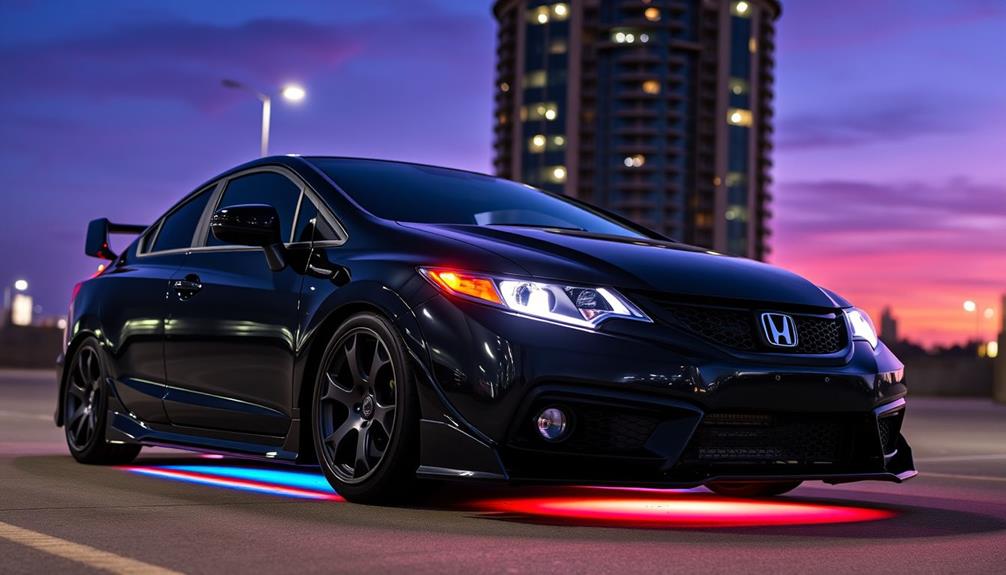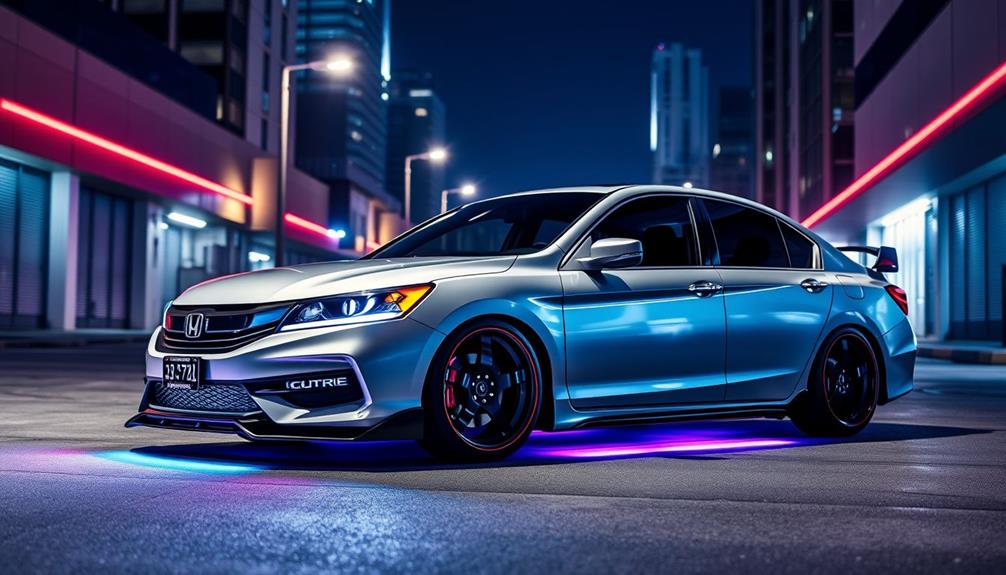You can definitely transform your 2019 Honda Civic sedan into a high-performance machine with the right tuning. Start with ECU tuning using tools like Ktuner to boost horsepower and throttle response. A cold air intake enhances airflow, while upgrading the exhaust system can improve exhaust flow. Keep in mind that performance gains are modest due to its naturally aspirated engine, so choose parts wisely to avoid engine codes. Regular maintenance and tuning adjustments will keep your upgrades running smoothly. There are plenty of options and community insights waiting for you to explore as you initiate this exciting journey.
Key Takeaways
- Upgrade your intake system with a cold air intake for improved airflow and throttle response, essential for tuning the 2.0L engine.
- Utilize ECU tuning software like Ktuner to optimize performance and enhance horsepower after making mechanical upgrades.
- Consider exhaust modifications, such as a catted downpipe, to improve exhaust flow and potentially increase power output.
- Engage in regular maintenance and tuning adjustments to ensure longevity and efficiency of your performance upgrades.
- Join online automotive communities for insights and shared experiences regarding effective tuning strategies for the 2019 Honda Civic.
Engine Overview
The heart of the 2019 Honda Civic is its 2.0L naturally aspirated K20C2 engine, delivering a solid 158 horsepower straight from the factory. This engine, available in various body styles—sedan, coupe, and hatchback—caters to a wide range of consumer preferences.
While it's a reliable powerplant, it lacks a turbocharger, which can limit your options for performance upgrades when compared to the 1.5L turbo variant. Understanding the engine's characteristics is essential if you want to maximize its potential within the naturally aspirated constraints.
Since the 2.0L engine isn't designed for extreme performance modifications, enthusiasts often look for ways to enhance its output. One of the best starting points is upgrading the exhaust system, which can improve airflow and potentially increase horsepower.
Additionally, just as coffee lovers explore different brewing methods to elevate their experience, car enthusiasts can benefit from experimenting with various modifications. While options for performance upgrades are more limited with this engine, focusing on quality modifications can lead to noticeable improvements.
You may consider enhancing the intake system or tuning the engine for better throttle response. By grasping the engine's capabilities and limitations, you can make informed decisions that align with your performance goals.
Recommended Performance Upgrades
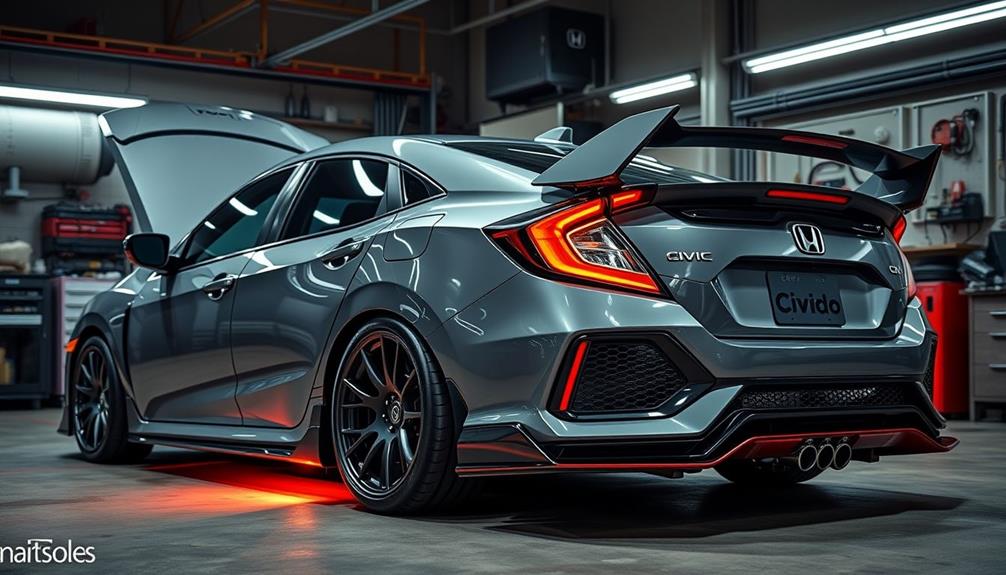
Maximizing the performance of your 2019 Honda Civic with the 2.0L NA engine involves selecting the right upgrades that can elevate your driving experience. One of the most effective upgrades is the Ktuner, which provides an ECU tune that enhances horsepower and improves throttle response. This modification can greatly change how your Civic feels on the road.
Additionally, opting for energy-efficient performance upgrades can reduce overall energy consumption considerably, much like the benefits of choosing the best heat pump.
Next, consider upgrading your intake system. An AEM cold air intake can improve airflow, but don't forget that tuning is often required to achieve the best performance gains.
To further enhance your car's output, installing a downpipe, such as the catted option from TSP, can improve exhaust flow. Keep in mind, though, that this might trigger engine codes, so monitor your vehicle's diagnostics closely.
While the naturally aspirated engine's constraints mean performance gains may be modest, combining intake and exhaust upgrades can yield noticeable improvements.
Regular maintenance and tuning adjustments are essential to guarantee the longevity and effectiveness of your upgraded components. With the right combination of parts and attention to detail, you can transform your Civic into a more spirited and enjoyable driving machine.
Understanding Naturally Aspirated Engines

When you're looking at the 2019 Honda Civic's 2.0L naturally aspirated K20C2 engine, it's important to understand how it works and its limitations.
Unlike turbocharged engines, this one relies solely on atmospheric pressure for air intake, which means performance upgrades are more restricted.
Understanding common financial terms can also help you budget for these modifications effectively.
You'll find that while options like a high-volume cold air intake can help, the gains are modest, so tuning becomes essential to make the most of your upgrades.
Engine Basics Explained
Understanding naturally aspirated (NA) engines is vital for anyone looking to tune their 2019 Honda Civic. The Civic's 2.0L K20C2 engine produces 158 horsepower, relying on atmospheric pressure to draw air in without the help of a turbocharger. This means the performance upgrades you make will be different than those for turbocharged setups.
To achieve ideal results, it's essential to focus on content relevance and authority, ensuring that your modifications align with best practices for NA engines.
For NA engines, enhancing the intake system is essential. By upgrading components like the air filter and intake manifold, you can improve airflow, leading to modest horsepower gains. Similarly, a well-designed exhaust system can help expel gases more efficiently, further enhancing performance.
However, don't expect drastic increases in power; NA engines typically offer limited gains compared to their turbocharged counterparts.
When tuning, you'll need to pay close attention to air-fuel mixtures and throttle response. Small adjustments in these areas can help you maximize the benefits of your upgrades.
Performance Limitations Overview
Recognizing the inherent performance limitations of naturally aspirated (NA) engines is essential for enthusiasts tuning their 2019 Honda Civic. The Civic's 2.0L NA engine produces a factory output of 158 horsepower, which already sets a ceiling on your potential performance upgrades compared to turbocharged variants.
Without a turbocharger, your upgrades will mainly rely on intake and exhaust modifications, like cold air intakes and downpipes. Understanding the significance of quality assurance in software development can also parallel the need for careful modifications in automotive tuning.
However, keep in mind that performance gains from these modifications are typically modest due to the lack of forced induction. This means you won't see significant power increases, which can be frustrating for those looking to boost performance.
Additionally, the aftermarket support for the 2.0L NA Civic is more limited compared to the 1.5L turbo variant, resulting in fewer performance parts and options.
When you do decide to upgrade components such as the intake system, tuning becomes essential. Modifications can affect your engine's air-fuel mixture and overall efficiency, so a proper tune is necessary to optimize performance.
Understanding these performance limitations will help you make informed decisions as you commence your tuning journey.
Upgrade Options Available
With the performance limitations of the 2.0L naturally aspirated engine in mind, exploring available upgrade options can help you maximize its potential.
Investing in energy-efficient appliances can provide similar benefits in performance and efficiency for the home, as seen in the Appliance Maintenance Plans. While upgrades for this engine may not yield dramatic gains, they can still enhance your driving experience.
Here are some key options to take into account:
- Cold Air Intake: A system like the AEM intake can improve airflow, providing a modest boost in horsepower and throttle response.
- Exhaust System: Upgrading your exhaust system, including downpipes, can enhance exhaust flow. Consider catted or non-catted designs, but be mindful of legality and engine codes.
- Tuning: Using a tuning solution like Ktuner is essential. It optimizes your engine's performance post-upgrade, ensuring you get the most out of your air intake and exhaust modifications.
Keep in mind that while you won't experience the same performance ceiling as turbocharged engines, these upgrades can still make a noticeable difference.
Combining these enhancements with proper tuning will help you reveal the potential of your Civic's naturally aspirated engine, making your sedan feel more spirited on the road.
Performance Limitations and Challenges
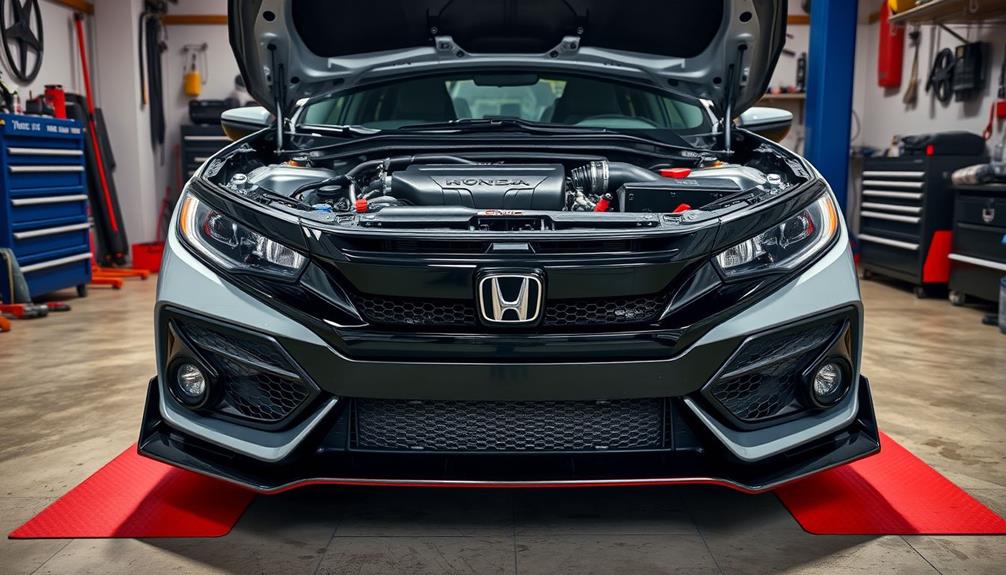
The performance limitations of the 2019 Honda Civic, especially the 2.0L naturally aspirated variant, can be frustrating for enthusiasts looking to maximize their vehicle's potential. Unlike the more popular 1.5L turbo model, your options for meaningful upgrades are limited. Modifications primarily focus on intake and downpipe enhancements, but you'll find that performance gains tend to be modest due to the absence of forced induction.
It's essential to recognize that, like selecting the right cold medications for effective relief, choosing the right performance parts for your Civic is equally significant for achieving desired results.
It is vital to take into account that installing certain downpipes may trigger an engine code, which can compromise your performance enhancements and overall reliability. This risk makes it essential to choose parts carefully and stay informed about potential issues. Additionally, the aftermarket support for the 2.0L NA Civic is sparse, making it challenging to find effective and compatible performance parts compared to turbocharged options.
Lastly, tuning plays a significant role in performance upgrades. You'll need to recalibrate your vehicle after modifications like cold air intakes to achieve the best efficiency and power output.
Steering through these challenges requires patience and diligence, but understanding these limitations can help you make informed decisions about your tuning journey.
Community Insights and Experiences

Engaging with online forums can greatly enhance your tuning experience with the 2019 Honda Civic.
These platforms provide a wealth of shared experiences and insights specific to your vehicle, helping you navigate the tuning landscape effectively.
Many enthusiasts emphasize the importance of ECU tuning, especially with KTuner, to truly maximize the performance gains from your upgrades.
As the demand for skilled professionals in AI cybersecurity jobs continues to rise, it's vital to reflect on how technology impacts automotive performance tuning and safety.
Here are some key community insights you'll want to keep in mind:
- Focus on cold air intakes and downpipes for modest improvements, especially on the 2.0L NA engine.
- Thorough research and planning are essential before modifications to guarantee compatibility and avoid potential issues, such as troublesome engine codes from certain downpipe installations.
- Explore innovative enhancements that cater to both performance and aesthetics, despite the inherent limitations of the 2.0L NA engine.
Tuning Considerations and Paths

When tuning your 2019 Honda Civic, it's essential to understand the differences between engine types and how they affect your modifications.
For peak performance, consider incorporating a balanced approach that includes both mechanical upgrades and lifestyle adjustments, such as tracking your progress and setting achievable goals, similar to effective strategies for weight loss.
You'll need to budget wisely for the upgrades you want, as costs can add up quickly.
Understanding Engine Types
Understanding engine types is essential for any Honda Civic enthusiast looking to tune their vehicle effectively. The 2019 Civic comes with either a 2.0L naturally aspirated (NA) engine or a 1.5L turbocharged variant. If you're working with the 2.0L NA engine, your tuning options are somewhat limited, but there are still effective paths to explore.
To enhance your tuning experience, consider incorporating elements of uplifting music to keep your motivation high as you work on your vehicle.
Consider these key tuning upgrades for your engine:
- Cold air intakes for improved airflow
- Downpipes to enhance exhaust flow
- ECU calibration tools like KTuner for better throttle response
Since the 2.0L NA engine lacks forced induction, performance gains from upgrades will be modest. You'll need to plan carefully, focusing on what yields the best results.
Also, don't forget about maintaining your engine oil quality; using high-performance engine oil can help guarantee your engine runs smoothly while you're pushing it to its limits.
Understanding the differences between naturally aspirated and turbocharged engines will guide your tuning journey. Turbo engines typically benefit from intercoolers and other enhancements, which aren't applicable to your 2.0L setup.
Stay informed, and you'll maximize your Civic's performance potential!
Budgeting for Modifications
Before you start making modifications to your 2019 Honda Civic, it's important to establish a clear budget. Performance upgrades can vary greatly in cost, especially with the 2.0L NA engine. Since gains are typically modest compared to turbocharged options, you'll need to allocate funds wisely.
Exploring best ways to make money online can help you find additional income sources to support your tuning projects.
Consider necessary tuning solutions like Ktuner, which is vital for optimizing performance after installing upgrades like a cold air intake and a downpipe. Remember to factor in potential additional costs for tuning software and hardware.
Certain downpipe choices could lead to engine code issues, so it's essential to account for that risk in your budget.
Researching and engaging with online forums can provide valuable insights. Other enthusiasts often share their experiences and can help you understand the expected return on investment for specific modifications.
This way, you'll make informed decisions about how to improve exhaust flow and overall performance.
ECU Tuning Options
ECU tuning is a powerful tool for releasing the full potential of your 2019 Honda Civic's 2.0L NA engine. By optimizing your engine's performance, you can greatly enhance horsepower and throttle response, especially when combined with upgrades like cold air intakes and downpipes.
One of the best options available is KTuner, known for its user-friendly interface and impressive results.
When considering ECU tuning, keep these essential points in mind:
- Choose the right setup: Understand the differences between naturally aspirated and forced induction systems.
- Monitor performance: The KTuner V2 features a 5-inch touchscreen for real-time data display, allowing you to track metrics without a laptop.
- Plan for maintenance: Regularly check upgraded components to guarantee longevity and performance.
With KTuner, you can make considerable improvements to your Civic while retaining the option to revert to the original settings if needed.
Just remember, successful tuning requires careful planning and an understanding of your vehicle's capabilities. Embrace ECU tuning to transform your Honda Civic into a high-performance machine that delivers an exhilarating driving experience. To achieve the best results, it’s important to work with a reputable tuning expert who has experience with Honda vehicles and understands the intricacies of ECU tuning. By investing in professional honda accord 2017 tuning, you can unlock the full potential of your car and enjoy improved horsepower, torque, and overall performance. With the right tuning modifications, your Honda Accord 2017 can become a standout on the road, providing a thrilling ride every time you hit the gas. Additionally, it’s essential to stay informed about the latest *Honda Civic 2018 tuning tips* to ensure you’re applying the most effective upgrades for your specific model. These insights can help guide your modifications, enhancing both the reliability and performance of your vehicle. Always prioritize quality parts and expert advice to ensure your tuning efforts result in a balanced, powerful, and enjoyable driving experience.
ECU Calibration and Software Setup
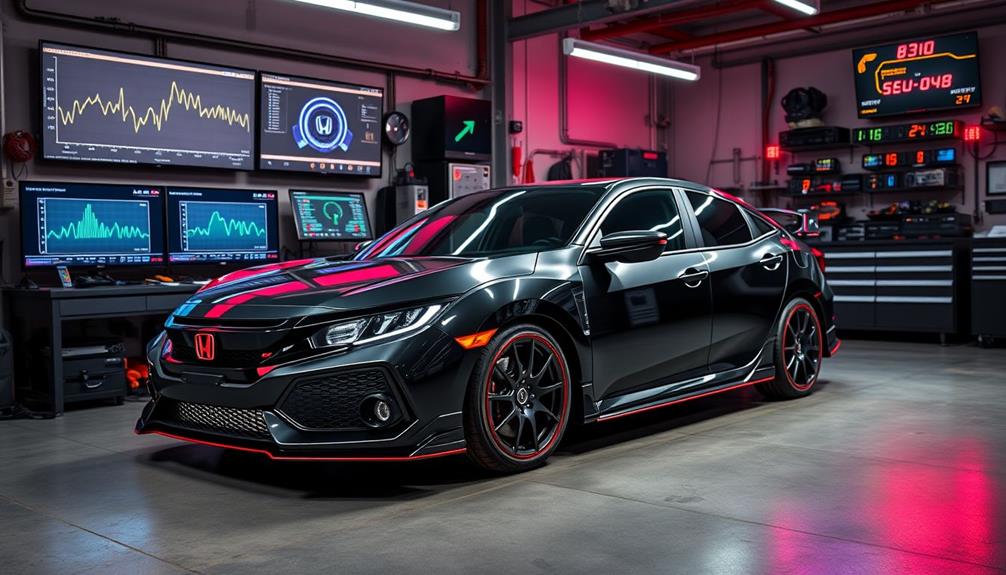
Tuning your Honda Civic's engine control unit (ECU) is essential for maximizing performance and responsiveness. Proper ECU calibration considerably boosts your car's horsepower and throttle response, particularly when you've upgraded components like cold air intakes and exhaust systems.
To start, consider using KTuner, which offers various versions tailored to your needs. The V1.2 is great for straightforward ECU calibration, while the V2 provides a touchscreen for real-time data display and easier navigation.
The calibration process involves creating a new tune based on your vehicle's specifications, selecting from preset tunes, and fine-tuning speed density maps for ideal performance at higher RPMs.
Key settings to adjust during the calibration include overall fuel trim, VTEC engagement points, rev limits, and idle speeds. These adjustments allow you to customize the driving experience to match your preferences.
Lastly, during the flashing process, pay careful attention to erase existing ECU data before uploading your new tunes. It's a good idea to use a battery charger to maintain power throughout the upload.
With these steps, you'll set your Honda Civic on the path to high performance.
Future Modifications and Enhancements

After enhancing your Honda Civic's ECU, it's time to reflect on future modifications that can elevate your car's performance to the next level. Here are some enhancements to take into account:
- Cold Air Intake: Installing a high-volume cold air intake from PRL Motorsports can greatly improve airflow, thanks to its HDPE rotomolded air box design. This upgrade will boost overall performance and throttle response.
- Catted Downpipe: Upgrading to a catted downpipe from TSP enhances your exhaust system's flow, potentially increasing horsepower. Just remember to check local emissions regulations, as this may impact legality.
- Ignition System Improvements: Explore options for upgrading your ignition system to guarantee peak spark delivery, which can further enhance engine efficiency and performance.
Additionally, take into account suspension modifications to improve handling and cornering capabilities.
Engaging with community forums and online resources can provide valuable insights from fellow Honda Civic owners, helping you choose the best upgrades for your specific needs.
With these modifications, you'll truly transform your Civic into a high-performance machine.
Frequently Asked Questions
How Can I Make My 2019 Honda Civic Faster?
To make your 2019 Honda Civic faster, consider upgrading the ECU with a KTuner, installing a high-volume cold air intake, and adding a catted downpipe paired with a quality catback exhaust for better performance.
How to Make 300 Hp in Honda Civic?
To make 300 hp in your Honda Civic, consider adding a turbocharger, high-flow intake, and performance exhaust. Don't forget to tune your ECU and monitor upgrades for reliability. Regular maintenance keeps everything running smoothly.
What Year of Honda Civic Is Best for Tuning?
If you're looking to tune a Honda Civic, the 2016-2021 models, especially the turbo variants like the Civic Si and Type R, offer the best performance potential. You won't regret diving into these options!
How Fast Can a Tuned Honda Civic Go?
A tuned Honda Civic can reach speeds around 130-140 mph, depending on modifications and aerodynamics. While you won't see dramatic acceleration improvements, you'll enjoy a more responsive and engaging driving experience overall.
Conclusion
Tuning your 2019 Honda Civic can be a thrilling journey, transforming your sedan into a true performer. As you explore upgrades and modifications, remember that every tweak you make is a step toward personalizing your ride. Coincidentally, this journey mirrors your own growth—just as your Civic becomes more powerful, you too evolve with each challenge faced. Embrace the process, share your experiences with the community, and enjoy the ride as you unleash your car's full potential. Keep in mind that the journey of tuning your 2019 Honda Civic never truly ends. As you unlock your car’s full potential, you may find yourself already dreaming of future power enhancements. Whether it’s a new exhaust system, upgraded turbocharger, or advanced engine tuning, the possibilities for enhancing your Civic are endless. Embrace the thrill of the journey and stay connected with other enthusiasts to stay updated on the latest advancements in car tuning. For those who are ready to take their tuning journey to the next level, exploring the world of honda accord 2017 tuning can provide even more opportunities for performance upgrades. Whether it’s upgrading suspension components, adding a cold air intake, or fine-tuning the engine for optimal power, there’s always more to be done to enhance your driving experience. Stay committed to the process, and enjoy the satisfaction of witnessing your vehicle’s continuous evolution. Remember, the journey of tuning is just as rewarding as the destination, so keep pushing the boundaries of what your 2019 Honda Civic or honda accord 2017 can achieve.



